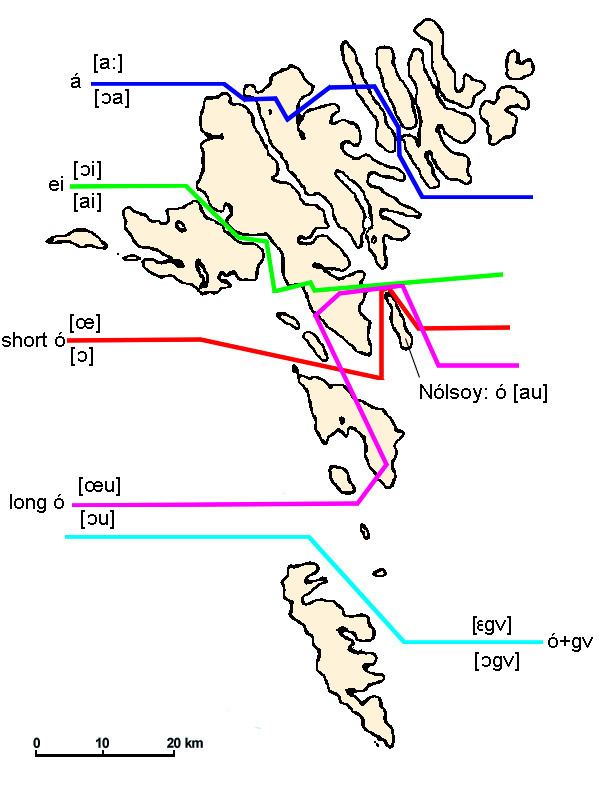Faroese has a sound system similar to closely related Icelandic, including such features as an aspiration contrast in stop consonants and a lack of vowel length, features rare among Germanic languages.
As with other Germanic languages, Faroese has a large number of vowel phonemes; by one analysis, long and short vowels may be considered separate phonemes, with 26 in total. Vowel distribution is similar to other North Germanic languages in that short vowels appear in closed syllables (those ending in consonant clusters or long consonants) and long vowels appearing in open syllables. Árnason (2011) provides the following alternations:
Faroese avoids having a hiatus between two vowels by inserting a glide between them.
There is considerable variation among dialects in the pronunciation of vowels.
The only unstressed vowels in Faroese are short [a, ɪ, ʊ]; these appear in inflectional endings: áðrenn (e.g. [ˈɔaːʐɪnː] 'before'). Very typical are endings like -ur, -ir, -ar. The dative is often indicated by [ʊn].
[a] – bátar [ˈpɔaːtaɹ] ('boats'), kallar [ˈkʰatlaɹ] ('[you] call')[ɪ] – gestir [ˈtʃɛstɪɹ] ('guests'), dugir [ˈtuːɪɹ] ('[you] can')[ʊ] – bátur [ˈpɔaːtʊɹ] ('boat'), gentur [tʃɛntʊɹ] ('girls'), rennur [ˈʐenːʊɹ] ('[you] run').In some dialects, unstressed short /ʊ/ is realized as [ø] or is reduced further to [ə]. /ɪ/ goes under a similar reduction pattern so unstressed /ʊ/ and /ɪ/ can rhyme. This can cause spelling mistakes related to these two vowels. The following table displays the different realizations in different dialects.
The so-called "skerping" ([ʃɛʂpɪŋk] 'sharpening') is a typical phenomenon of fronting back vowels before [kv] and monophthongizing certain diphthongs before long [tʃː]. Skerping is not indicated orthographically.
[ɛɡv]: Jógvan [ˈjɛkvan] (a form of the name John), Gjógv [tʃɛkv] ('cleft')[ɪɡv]: kúgv [kʰɪkv] ('cow'), trúgva [ˈtʂɪkva] ('believe'), but: trúleysur [ˈtʂʉuːlɛisʊɹ] ('faithless')[ɛtʃː]: heyggjur [ˈhɛtʃːʊɹ] ('high'), but heygnum [ˈhɛiːnʊn] ('high [dat. sg.]')[ʊtʃː]: nýggjur [ˈnʊtʃːʊɹ] ('new [M.]'), but nýtt [nʊiʰtː] ('New [Nn.]')[atʃː]: beiggi [ˈpatʃːɪ] ('brother')[ɔtʃː]: oyggj [ɔtʃː] ('island'), but oynna [ˈɔitnːa] ('island [acc. sg.]')/f, v/ are normally labiodental.Intervocalic /v/ is normally an approximant [ʋ], whereas word-initial /v/ varies between an approximant [ʋ] and a fricative [v]./n/ is dental [n̪], whereas /tʰ, t/ vary between being dental [t̪ʰ, t̪] and (less commonly) alveolar [tʰ, t].Initial /l/ is dental [l̪] or alveolar [l]. Postvocalic /l/ may be more of a postalveolar lateral [l̠], especially after back vowels./tʃʰ, tʃ/ are palato-alveolar, and vary between stops [t̠ʲʰ, t̠ʲ] and affricates [tʃʰ, tʃ]./ŋ, kʰ, k/ are velar, whereas /h/ is glottal.There are several phonological processes involved in Faroese, including:
Liquids are devoiced before voiceless consonantsNasals generally assume the place of articulation and laryngeal settings of following consonants.Velar stops palatalize to postalveolar affricates before /iː, ɪ, eː, ɛ, ɛi, j/./v/ becomes /f/ before voiceless consonants/s/ before another consonant becomes /ʃ/ after /ɛi, ai, ɔi//sk/ becomes /ʃ/ before /iː, ɪ, eː, ɛ, ɛi, j/ (but in morphological forms often /stʃ/ word internally, i.e. elski [ɛɬstʃɛ] 'I love')/ɹ/ retroflexes itself as well as following consonants in consonant clusters, yielding the allophones [ʂ, ɭ, ʈ, ɳ] while /ɹ/ itself becomes [ɻ], example: ⟨rd⟩ [ɻʈ]; preaspirated consonats devoice the rhotic: example: ⟨rt⟩ [ɻ̊ʈ]; ⟨rs⟩ is usually [ʂː] (only in some loanwords [ɻ̊ʂ]). Voiceless [ɻ̊] is usually realised as [ʂ].Pre-stopping of original ⟨ll⟩ to [tl] and ⟨nn⟩ to [tn].Intervocalically the aspirated consonants become pre-aspirated unless followed by a closed vowel. In clusters, the preaspiration merges with a preceding nasal or apical approximant, rendering them voiceless, example: ⟨nt⟩ [n̥t]Faroese tends to omit the first or second consonant in clusters of different consonants:
fjals [fjals] ('mountain's') instead of *[fjatls] from [fjatl] (nom.). Other examples for genitives are: barns [ˈpans] ('child's'), vatns [van̥s] ('water's').hjálpti [jɔɬtɛ] ('helped') past sg. instead of *[ˈjɔɬpta] from hjálpa [ˈjɔɬpa]. Other examples for past forms are: sigldi [ˈsɪltɛ] ('sailed'), yrkti [ˈɪʂtɛ] ('wrote poetry').homophone are fylgdi ('followed') and fygldi ('caught birds with a net'): [ˈfɪltɛ].skt will be:- [st] in words of more than one syllable: føroyskt [ˈføːɹɪst] ('Faroese' n. sg.;) russiskt [ˈɹʊsːɪst] ('Russian' n. sg.), íslendskt [ˈʊʃlɛŋ̊st] ('Icelandic' n. sg.).
- [kst] in monosyllables: enskt [ɛŋ̊kst] ('English' n. sg.), danskt [taŋ̊kst] ('Danish' n. sg.), franskt [fɹaŋ̊kst] ('French' n. sg.), spanskt [spaŋ̊kst] ('Spanish' n. sg.), svenskt [svɛŋ̊kst] ('Swedish' n. sg.), týskt [tʰʊkst] ('German' n. sg.).
- However [ʂt] in: írskt [ʊʂt] ('Irish' n. sg.), norskt [nɔʂt] ('Norwegian' n. sg.)

